Our services
Our core services are focused on our statutory duties to prevent, protect and respond to fires and other emergencies. They are informed and shaped by our analysis of risk, and we align our resources and focus our activities on the areas of greater risk.
Prevention and community engagement
The aims of our prevention work are to reduce the risk of harm to individuals from fires in their homes, and from incidents on the roads and in the water.
We seek to engage with people at all stages of life, targeting those groups and individuals who are at the highest risk of harm.
- Early Years
-
School & nursery visits
Aim: Raise awareness of fire risks, promote the fire service as a career
Target: Schools in areas of high risk, but also by request
-
Safety Zone - mulit agency activity
Aim: Promote fire, water and road safety
Target: School children from higher risk areas
-
- Young adults
-
Student fairs
Aim: Promote safe cooking, fire safety in the home
Target: University students
-
Fire safety intervention
Aim: Address concerning behaviours relating to fire setting
Target: Individual young people referred from partner agencies
-
Road safety - fatal four
Aim: Promote safe driving, highlighting four main dangerous behaviours
Target: People referred by partner agencies
-
Fire safety intervention
Aim: Address concerning behaviours relating to fire setting
Target: Individual young people referred from partner agencies
-
- Working age adults & families
-
Homelessness shelter - in partnership with City and County councils
Aim: To provide shelter and support for homeless people during periods of cold weather
Target: People living rough in the City and County
-
Biker down
Aim: Promote road safety
Target: Motorcyclists
-
Data and intelligencel led engagement
Aim: Promote safety advice and smoke alarm ownership and identify people who would benefit from a Safe and Well visit
Target: Properties in areas where smoke alarm ownership is likely to be low
-
Community reasuurance and engagement
Aim: Promote safety advice in the aftermath of a serious incident
Target: People living, working or visiting the immediate vicinity of the incident
-
Press to Test - email service to remind people to test their smoke alarms
Aim: To provide regular emails containing safety advice and encourage people to test their smoke alarms regularly
Target: Subscribers to service
-
Safe and Well visit - individual home visit
Aim: Reduce specific risks of fire in home
Target: Vulnerable people assessed as high risk on CHARLIE risk profile
-
- Later life
-
Occupational therapist visit
Aim: To assess needs and arrange support for people with complex needs
Target: Individuals referred by colleagues or partners
-
Safeguarding referrals
Aim: To protect children and vulnerable adults from harm or exploitation
-
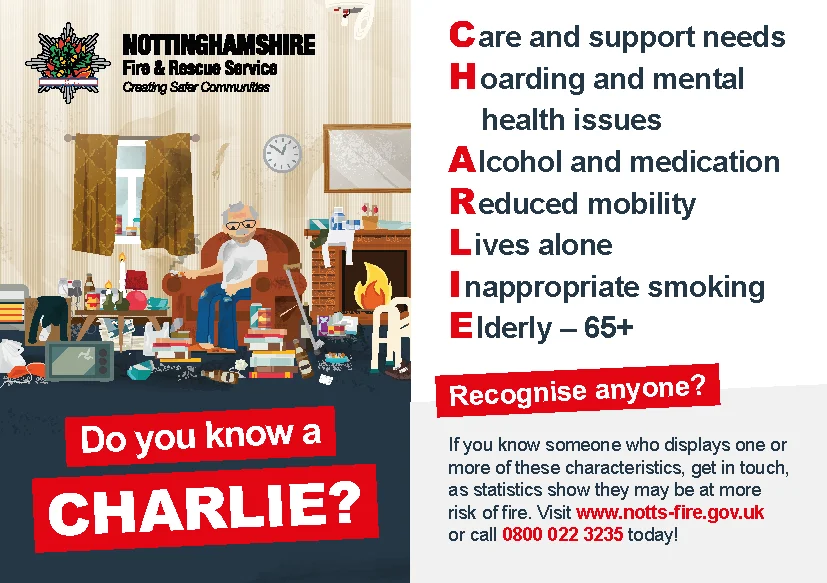
Our community engagement activities
Community engagement takes many forms from spending time out and about in our communities, attending events, to media campaigns.
Community befriending scheme
Aim: Improve community engagement and promote service as employer
Target: Under-represented and minoritised community groups
Have a go days
Aim: To encourage people to consider a career as a firefighter
Target: Individuals who may be interested in joining the service, particularly from groups that are currently under-represented in the workforce
Community events - attendance at local events, such as Pride, Emergency Services Day, Nottingham Carnival, local fetes and carnivals
Aim: Positive service visiability and reputation, promote service as employer of choice, raise awareness of safety issues
Target: Local communities
Station open days
Aim: Build relationships with local communities, raise awareness of our services and promote the service as an employer of choice
Target: Local residents in station area
National safety campaigns - focused on specific fire, road and water risks
Aim: Raise awareness of specific risks aligned to NFCC campaigns calender
Target: General population
"Yes, you can" campaigns
Aim: To attract applicants to join service in on-call capacity
Target: People who live or work near an on-call fire station
Community Advisory Group
Aim: To build relationships with community leaders to help us understand needs and develop and deliver services
Target: Minoritised communities

Fire investigation
Our team of specialist fire investigators attend fire incidents where the cause is unclear, to detect the probable source and cause of ignition. Their findings are used to inform future prevention activities. Where the cause is suspicious they work with police colleagues to identify and collect evidence
Partnerships and collaborations
We work in partnership and collaboration with a range of other partners and organisations, to build relationships and provide targeted services.
Safelincs - online tool for home fire safety advice
Aim: To allow self-assessment and mitigation of risks and generate referrals for home visits where the risk is high
Road safety partnership
Aim: To reduce deaths and injuries on Nottinghamshire's roads
Water safety partnership
Aim: To reduce deaths and injuries from incidents in open water
Antisocial behaviour tasking groups
Aim: To reduce antisocial behaviour and mitigate its effect
Strategic partnerships
Aim: To deliver our statutory duties in relation to Safeguarding, Prevent (countering violent extremism), Serious Violence, Violence againsts Women & Girls, Health & Wellbeing and Community Safety
CHARLIE training
Aim: Training for partner agencies, particularly in health and social care sector on how to assess the risk of fire for individuals they work with, using our CHARLIE risk assessment tool
Red routes and safe spaces
Aim: To provide reassurance and support partnership approaches to reduce crime
StayWise - educational resources and activities
Aim: The delivery of nationally standardised learning resources for our community safety practitioners to use in delivering safety messages
Fire dogs - a shared resource across East Mmidlands fire services
Aim: Specially trained hydrocarbon detection dogs, used to detect the source and support prosecutions of deliberate fires.
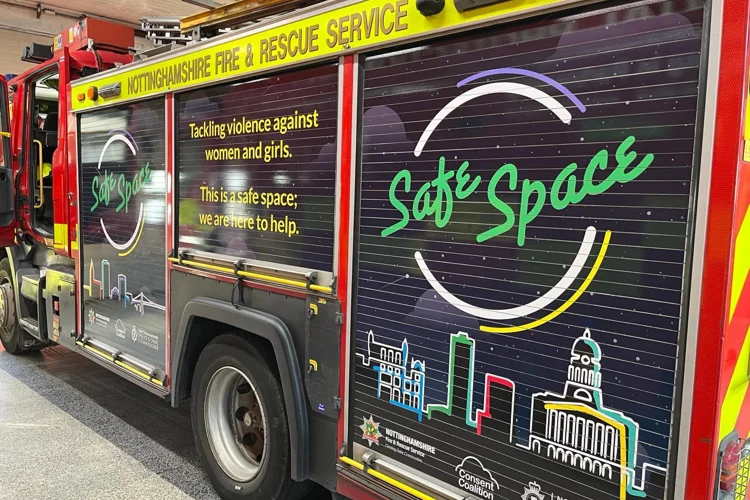
Protection and business engagement
Our protection activities focus on fire safety in non-domestic premises, including commercial buildings, workplaces, public buildings like hospitals, theatres, venues, care homes, tall buildings, and apartment blocks. We collaborate with partners to ensure safety and work closely with businesses to minimise the impact of incidents when they do occur. We are responsible for enforcing fire and building safety legislation (Regulatory Reform (Fire Safety) Order 2005) as the regulating authority for Nottingham and Nottinghamshire.
Our protection and business engagement activities
- Design
-
Building consultations
Aim: Provide statutory consultation for buildings that will fall under the Fire Safety Order 2005 once built
Target: All appropriate building consultations
-
Support for Building Safety Regulator
Aim: Provide professional support, expert advice and monitoring of the development of high-rise residential buildings
Target: All relevant developments within the Building Safety Act 2021
-
- Construction
-
Safety Advisory Groups
Aim: To provide professional support and expert advice on fire safety at large venues or events
Target: Relevant local authorities
-
Licensing consultations
Aim: Provide professional fire safety opinion on licencing applications
Target: All licensing applications
-
- Occupation
-
Fire safety seminars
Aim: Guidance to on how to complete a fire risk assessment, advice and support on the demands of Fire Safety legislation
Target: New business owners and responsible persons
-
Joint Audit and Inspection Team - in partnership with City Council
Aim: A joined up approach to ensure fire safety compliance in high risk residential buildings
Target: High risk residential buildings within the City
-
Fire safety audits
Aim: To regulate compliance with relevant fire safety legislation
Target: High risk premises identified within our risk-based inspection programme
-
Business Support
Aim: Provide advice and guidance to business on their responsibilities in relation to fire safety regulations and provide ongoing support relating to business continuity
Target: Designated Responsible Persons
-
Complaints
Aim: To respond to complaints and concerns relating to fire safety measures in regulated premises
Target: Premises referred to us
-
Diverse interaction and business support (DIBS)
Aim: Engagement and education of businesses in diverse communities
Target: Specific premises in a targeted community
-
Business safety checks
Aim: To regulate compliance with relevant fire safety legislation
Target: Premises identified as being lower risk
-
Unwanted fire signal reduction
Aim: To reduce the number of repeat mobilisations to fire alarm activation as a result of poor fire safety management
Target: Premises that trigger multiple mobilisations
-
- Post-incident response
-
Post fire inspection
Aim: To provide support and advice on business recovery and avoid future incidents
Target: Premises within the scope of the Fire Safety Order 2005 that have experianced a fire
-
Enforcement action
Aim: To enforce legislation when regulated premise are not compliant with relevant legislation, from providing advice through to prosecution, all conducted in line with the Regulator's Code
Target: Responsible Persons for regulated premises
-
Business reassurance and engagement
Aim: Promotes safety advice following a significant fire in a business premises
Target: Premises in the vicinity of a significant incident
-
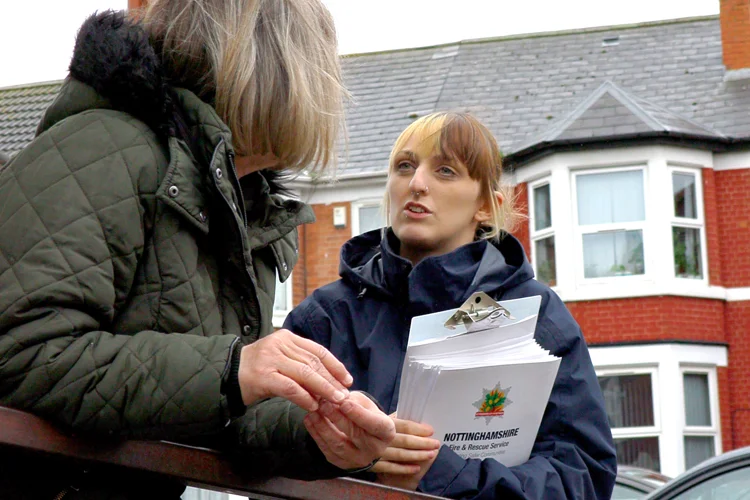
Response
Our statutory duty to prepare for, and respond to, emergencies is covered by the Civil Contingencies Act 2004 and the Fire and Rescue Services Act 2004.
We have 24 fire stations strategically positioned across the county:
11
are staffed 24/7 by wholetime crews, three of these also have on-call crews
1
is staffed by a wholetime crew during the day, with on-call cover at night
12
are staffed by an on-call crew
They host 30 fire appliances and a range of specialist vehicles including two aerial ladder platforms, command and welfare support vehicles, specialist rescue units, and a high-volume pump. To ensure appropriate supervision and control at more complex incidents, a cadre of 30 officers are available on a rota system to deploy to incidents and take overall control of these situations.
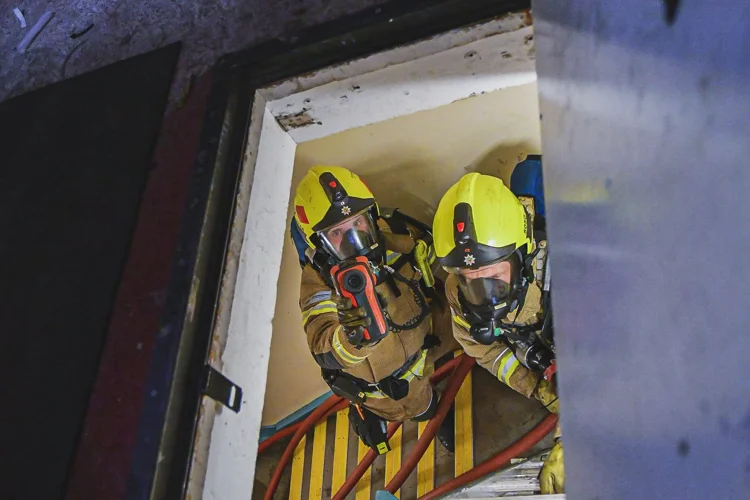
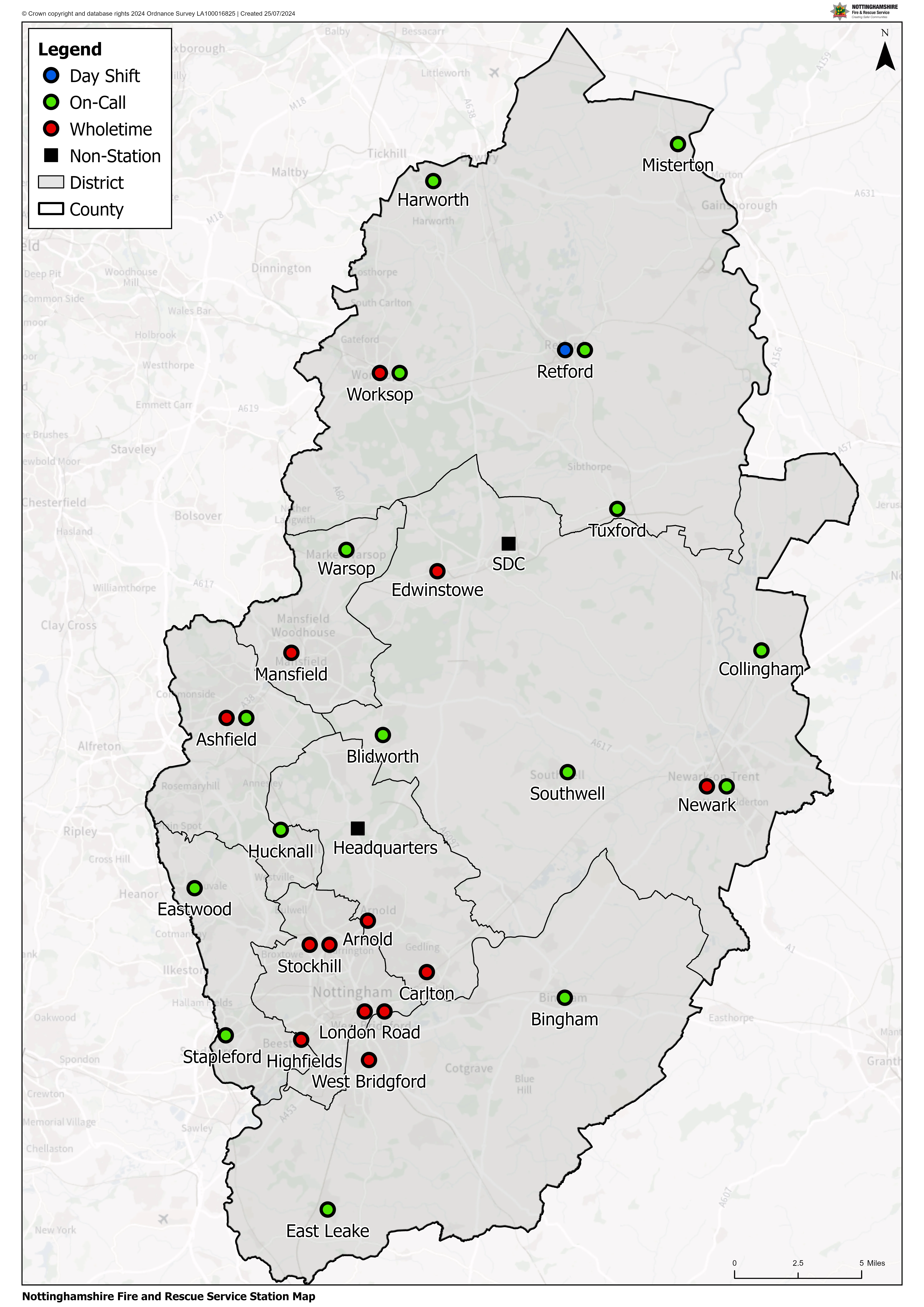
Our operational response activities
To deliver our operational response safely and effectively takes considerable preparation, training and exercising. This ensures we are there for our communities when they need us. We monitor and assure our incident response to gather any operational learning that we can use to improve our own performance. We share learning with other partners and fire services to improve safety and effectiveness across the sector.
Operational preparedness
Emergency planning and preparation
Working with partners as a member of the Local Resilience Forum, with neighbouring fire services, and internally to plan and prepare for major or complex incidents requiring multi-agency response.
Maintaining risk information
Visiting targeted premises to capture site specific risk information and develop tactical plans for dealing with incidents.
Operational training and maintenance of competence
Mix of practical and desk-based training to equip firefighters with skills and knowledge to deal safely and effectively with any type of incident.
Exercises and drills
Practical and tabletop exercises to test the effectiveness of plans, often in partnership with neighbouring fire services and other blue light partners.
Operational response
Receiving calls
Joint Fire Control take 999 calls and mobilise the appropriate response depending on the type and severity of incident.
Responding to local incidents
We aim to reach all incidents within an average of 8 minutes from the time the first appliance is mobilised. We have a range of specialist appliances and specially trained officers that we can send to an incident as required. We have mutual aid arrangements with our neighbouring services that allow us to request or provide resources to help with incident response.
Responding to national incidents
We have specialist capabilities for larger scale incidents such as flooding and terrorist attacks which we can deploy anywhere in the country at the request of other services. We can similarly call on other services for their support.
Operational learning
Incident debrief
A debrief is conducted after every incident to capture any learning and check on the welfare of those who attended.
Operational assurance
Monitors incident trends, coordinates risk information updates and the sharing of learning, and quality assure response practices.
Shared learning
Information from operational incident debriefs, monitoring and feedback drives continuous improvement through updates to training and operational practices. Where relevant this learning is shared through regional and national channels.
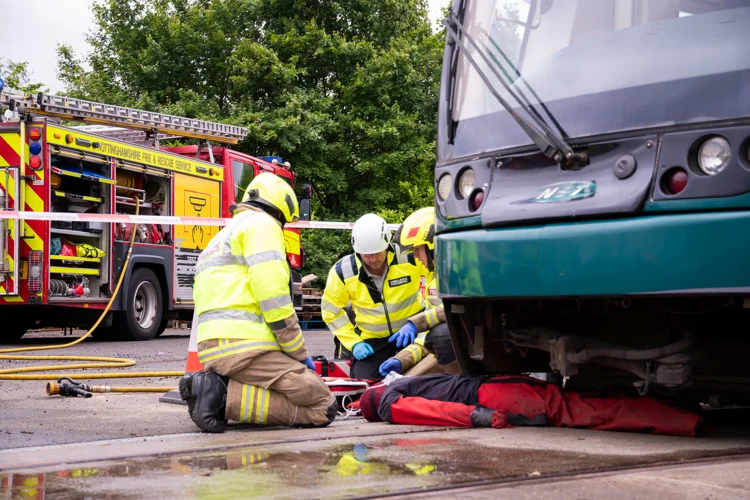
In an average year in Nottinghamshire we:
Attend over 10,500 incidents, typically including around 3,400 fires, over 560 road traffic collisions, and over 4,500 false alarms
Respond to calls for help in an average of 8 minutes from the time the first fire engine is mobilised
Attend around 1,500 incidents to provide humanitarian assistance and rescues of people
Carry out over 16,000 Safe and Well visits, targeting those people at a higher risk of having a fire at home
Carry out over 2,200 engagements with businesses to ensure compliance with fire safety legislation
We deliver over 700 training events, from a portfolio of over 140 courses, which are attended by more than 3,000 delegates